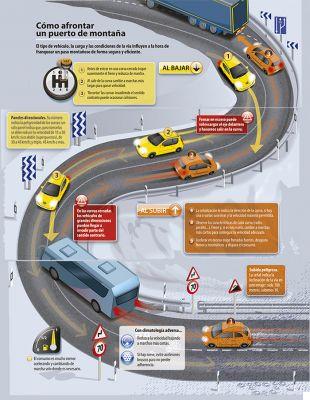
Driving on slopes can be a challenge for many drivers, especially those who are not used to this type of terrain. In this article, we'll provide you with tips and techniques to help you drive your vehicle safely and enhance your hill-driving experience.
How to start on a hill
Starting on a hill can be difficult if not done correctly. Here we show you the steps you must follow:
Step 1: Use the parking brake
Before starting on a hill, be sure to apply the parking brake to prevent the vehicle from rolling backwards. This will give you enough time to release the clutch and accelerate smoothly.
Step 2: Step on the clutch
Once you're ready to go, push the clutch all the way in. This will prevent the vehicle from moving while you shift.
Step 3: Engage First Gear
Engage first gear and keep your foot on the clutch. Make sure you have your right foot on the brake pedal to control the speed of the vehicle.
Step 4: Release the parking brake
Slowly release the parking brake while keeping your foot on the clutch. This will allow the vehicle to start moving forward without rolling backwards.
Step 5: Release the clutch gradually
Once you've released the parking brake, begin to gradually release the clutch while accelerating smoothly. You must do this slowly and steadily to prevent the vehicle from stalling or jerking.
Remember to practice this procedure on a safe, flat area before attempting it on a steep slope.
How to properly use the clutch when going uphill
Going uphill can be an extra challenge, but with the following tips you can do it safely:
Step 1: Use the parking brake
As with starting on a hill, use the parking brake to prevent the vehicle from rolling backwards while you change gear.
Step 2: Step on the clutch
Fully depress the clutch and keep your foot on the brake pedal. This will prevent the vehicle from moving while you shift.
Step 3: Engage First Gear
Engage first gear and keep your foot on the clutch. Make sure you have your right foot on the brake pedal to control the speed of the vehicle.
Step 4: Release the parking brake
Slowly release the parking brake while keeping your foot on the clutch. This will allow the vehicle to start moving forward without rolling backwards.
Step 5: Release the clutch gradually
Once you've released the parking brake, begin to gradually release the clutch while accelerating smoothly. You must do this slowly and steadily to prevent the vehicle from stalling or jerking.
Remember to maintain a constant speed and use the brake properly to control the vehicle as you go up the hill.
How to drive on slopes
Driving on slopes requires some additional techniques to ensure your safety and that of other drivers. Here are some tips:
Keep a safe distance
When driving on slopes, it is important to keep a safe distance from the vehicle in front of you. This will give you plenty of reaction time if the vehicle stops or moves suddenly.
Use the brake properly
When going downhill, use the brake appropriately to control the speed of the vehicle. Avoid braking hard, as this can cause the brakes to overheat and lose effectiveness.
Use the right gears
When going up or down a hill, use the appropriate gears to maintain control of the vehicle. Shift to a lower gear when going uphill and a higher gear when going downhill to prevent over-stressing the engine.
Avoid sudden acceleration or braking
When driving on slopes, avoid harsh acceleration or braking. This can cause the vehicle to become unstable and you lose control. Maintain smooth and steady acceleration and braking.
How to release the clutch correctly
Releasing the clutch correctly is essential to prevent damage to the vehicle and ensure a smooth ride. Follow these steps:
Step 1: Depress the clutch all the way
Before changing gears or starting off, be sure to fully depress the clutch. This will disconnect the engine from the transmission and allow any necessary changes to be made.
Step 2: Release the clutch gradually
Once you've made the necessary shifts, begin to gradually release the clutch while accelerating smoothly. You must do this slowly and steadily to prevent the vehicle from stalling or jerking.
Step 3: Avoid releasing the clutch too quickly
Avoid releasing the clutch too quickly, as this can cause premature clutch wear and transmission damage. Release the clutch in a smooth and controlled manner.
Step 4: Practice in a safe area
If you are new to driving or unfamiliar with clutch operation, it is advisable to practice on a safe, flat area before tackling steep grades.
Frequently Asked Questions (FAQs)
1. Is it necessary to use the parking brake when starting on a hill?
Yes, it is recommended to use the parking brake when starting on a hill to prevent the vehicle from rolling backwards while changing gears. This will give you enough time to release the clutch and accelerate smoothly.
2. What is the proper gear when going uphill?
The proper gear when climbing a slope will depend on the inclination of it. In general, it is recommended to use a lower gear to avoid overtaxing the engine.
3. How can I prevent the vehicle from rolling backwards when starting on a hill?
To prevent the vehicle from rolling backwards when starting on a hill, apply the parking brake and release it slowly while keeping your foot on the clutch. This will allow the vehicle to start moving forward without rolling backwards.
Conclusion
Driving on slopes can be challenging, but with the right tips and techniques, you will be able to operate your vehicle safely and enhance your driving experience on this type of terrain. Remember to practice in a safe area before facing


























